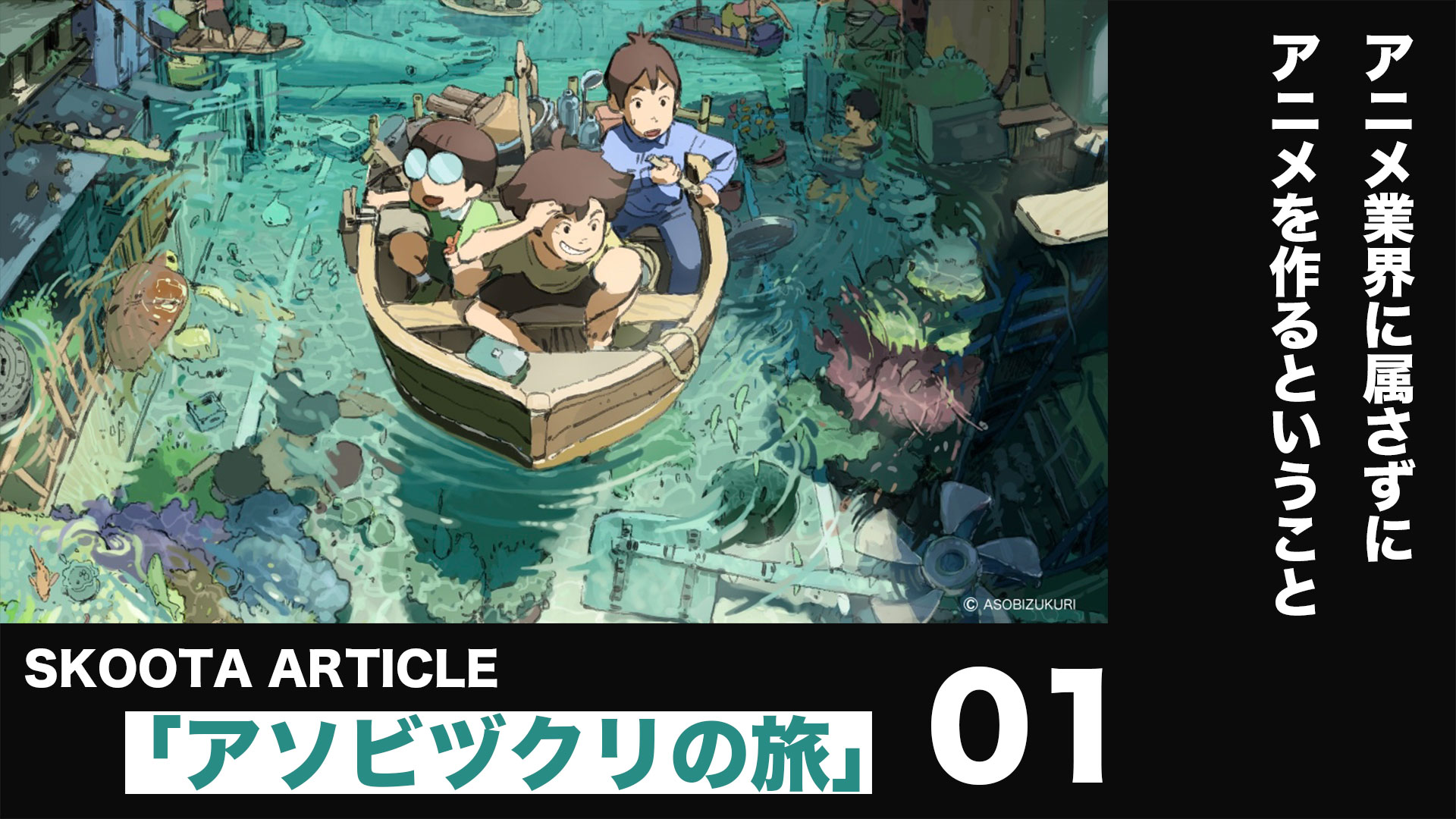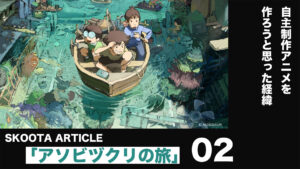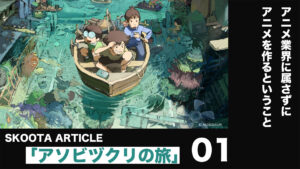
Guset / Personality
Guest: Asobizukuri
An anime team founded in Tokyo in 2018 by Yamamoto, a planner and marketer, and Shimoda, a creator, with the theme of “Extending Play by Creating Play.” Their work is characterized by creative ideas that combine innovative concepts with meticulous technical skills, all while maintaining a sense of playfulness and deep thought.
Akihiro Yamamoto
Planner & Marketer
Born in 1998, 25 years old.
After graduating from high school, he joined an anime company as an animator but was dismissed after about a year due to a lack of skills. Later, he met Shimoda on Twitter, and they began working on independent anime productions, though their first project fell through. During this time, he started organizing sketching sessions to expand his network. A doujinshi (self-published work) of sketches he released as an extension of this activity became a hit, and he now makes a living from that while continuing to work on independent anime projects.
Kentaro Shimoda
Illustrator & Creator
Born in 1997, 26 years old.
After graduating from night high school, he worked part-time at a Yamazaki bread factory and drifted for a while until meeting Yamamoto on Twitter. As the two of them spent time drawing in Inokashira Park, they decided to turn their sketches into anime, leading to the start of their serious collaboration.
Host: Yuki Sakoda
After working in a telecommunications company and a general advertising agency, Sakoda founded an anime planning and production company, producing videos ranging from MVs to films. In 2021, he moved to Kyoto and began working to revitalize the entertainment industry there. Recently, he has been involved in the entertainment fields of manga and audio, planning and producing audio dramas and webtoons. Additionally, he serves as a producer and advisor for several entertainment companies.
Table of contetns
#01
Yamamoto started as an animator, but…
Yamamoto and Shimoda connected through Twitter.
The junk town filled with childhood dreams.
Consumed fantasy works.
Inspired by “Summer Wars” to aim for the anime industry.
Shimoda, who drew while working part-time.
Creating anime without belonging to the anime industry.
Conflicts over the length of the animation.
#02
The background behind the decision to create independent anime.
The sketching sessions the two held at Inokashira Park.
Reflections on creating anime within the industry.
High risk, low return.
Shimoda’s sketches provided balance.
#03
What does “play” mean to the two members of Asobizukuri?
Something they can become fully absorbed in.
The ability to understand structures.
Gaining a sense of the physicality of objects through sketching.
Creating spaces where play is possible.
Asobizukuri’s perspective on storytelling.
Yamamoto and Shimoda Connected Through Twitter
Sakoda:
Asobizukuri is a creative unit consisting of two people, and today we’ll be talking with both of them. But first, let me introduce this anime team called Asobizukuri. The team was established in Tokyo in 2018 by Yamamoto, a planner and marketer, and Shimoda, a creator, with the theme of “Extending Play by Creating Play.” Their work is characterized by creative ideas that combine innovative concepts with meticulous technical skills, all while maintaining a sense of playfulness and deep thought. Today, we have Akihiro Yamamoto and Kentaro Shimoda with us. Thank you for joining us.
Yamamoto & Shimoda:
Thank you for having us.
Sakoda:
This radio show aims to delve into the journey of our guests’ lives. So, I’d like to go back in time a bit and explore how the two of you have reached your current point. Since there are two of you, we’ll talk with each of you individually, and then focus on the points where your paths intersected. Let’s start by exploring Yamamoto’s profile and journey. Is that okay?
Yamamoto:
Yes, thank you.
Sakoda:
Yamamoto, you are in charge of planning and marketing at Asobizukuri. According to your profile, after graduating from high school, you joined an anime company as an animator. So, even though you’re now in planning and marketing, you initially started as an animator.
Yamamoto:
Yes, that’s right.
Sakoda:
I see. I’m sure there’s a story that led to where you are now, which we’ll get into later. According to your profile, you mentioned that you were let go after about a year due to a lack of skills. After that, you met Shimoda on Twitter, and you two decided to make an independent anime together, although the first project fell through.
It seems that, in your journey, you met Shimoda fairly early after joining the anime company, and then embarked on the path of independent production. What was the flow of events like at that time?
Yamamoto:
Well, let’s see… I got fired in January—or rather, at the end of December. Then, I met Shimoda for the first time in January. We didn’t see each other for a while after that because Shimoda was busy, but we met again around May, and that’s when we decided to make an independent anime together.
Sakoda:
At that time, did you already have a desire to continue working in anime or video production, even after leaving the company? Did you feel more inclined to do something on your own with Shimoda rather than working within a company?
Yamamoto:
Well, maybe deep down, there was some of that. But at the time, I was just feeling the pain of my lack of skills and the confusion of losing my job. I didn’t really know how to move forward in life. So when I reached out to Shimoda, whom I admired as a creator, it was more like seeking life advice. I wasn’t even thinking about continuing with anime—I just wanted to talk.
Sakoda:
I see. At that time, you had been observing Shimoda from a distance. Was Shimoda posting his creative work on Twitter or something similar?
Yamamoto:
Yes, that’s right. And just before I got fired, Shimoda followed me back on Twitter, so I thought, “Okay, maybe it’s okay to reach out,” and I did.
Sakoda:
So that’s where it all started. Looking at Asobizukuri’s activities now in 2023, including on Twitter, it seems like things are going smoothly. But it’s surprising to learn that your career started with a setback, followed by a new encounter that brought you to where you are now.
Now, I’d like to switch the conversation to Shimoda. You were discovered by Yamamoto, and according to the profile we have, after graduating from a part-time high school, you were working part-time at a Yamazaki bread factory and met Yamamoto on Twitter while in a period of drifting. During the time that Yamamoto mentioned, were you drawing and posting things on Twitter while working part-time?
Shimoda:
Yes, that’s right. After graduating from high school, I kept working part-time. I had been on Twitter since around the time I started high school, so I think Yamamoto recognized me somewhere along the way. Then, while I was working part-time, I suddenly got a DM saying, “Would you like to meet?” and I was like, “Sure,” and we met.
Sakoda:
What was the trigger that led to that meeting? I ask because many creators are looking for collaborators, but it’s often hard to reach out, and it can also be challenging for those who are approached to respond. I’m curious about how the two of you communicated and what made your first impression so positive that it led to this smooth relationship.
Shimoda:
It might not be very helpful, but it was just an unexpected message asking, “Can we meet?” and I didn’t really think much about it—I just said, “Sure.” We probably had some conversation, but I got the impression that Yamamoto wasn’t a dangerous person, so I just went ahead and met him.
Sakoda:
And Yamamoto, how did you decide to contact Shimoda? Was it more of a spontaneous decision?
Yamamoto:
It wasn’t so much a decision as it was a feeling of being lost in life, not knowing what the right move was. The one thing that caught my interest was contacting Shimoda. I wasn’t particularly excited, but it was the only interesting option I had, so I reached out.
Sakoda:
Hearing that, Shimoda, did you feel grateful or happy about it?
Shimoda:
I did have the thought, “Am I really the right person for this?”
Sakoda:
What about Shimoda’s creative work made you think, “This is great,” when you decided to contact him?
Yamamoto:
Well, Shimoda was drawing exactly the kind of illustrations I wanted to draw. And given that we were close in age, I thought, “This is what real talent looks like.” It made me realize that maybe I wasn’t cut out for this—people like Shimoda are the ones who succeed as artists. Uh, what was the question again? (laughs)
Sakoda:
What caught your attention in Shimoda’s creative work at that time?
Yamamoto:
Yes, it was his fantasy-style illustrations. And I’ve always liked visuals similar to Ghibli’s. Shimoda’s world-building was very much in line with that national, iconic style… something like that.
Sakoda:
Shimoda, I’d like to ask you—while it might be difficult to analyze yourself, there are certain iconic elements that resonate with the Japanese public, like those found in Ghibli works. What do you think it is about your creative work that gives it this national, iconic quality?
Shimoda:
Iconic quality… I’m not sure. But I also really like Ghibli’s works, so it’s not something I discovered on my own—it’s more like I’ve been exposed to and influenced by those kinds of works. I think it’s a result of watching and absorbing my favorite works, which then naturally comes out in my drawings.
Sakoda:
Have you done a lot of input and charging, so to speak?
Shimoda:
I might not have seen as many as some others, but I do like Ghibli’s works, as well as foreign fantasy films. Around the time I graduated from high school, I started borrowing DVDs and watching them, and I even did some copying from them. I think I’ve absorbed a lot more from fantasy films than from anime.
Sakoda:
What are some foreign fantasy works that come to mind as examples of what you’ve absorbed?
Shimoda:
One that comes to mind is “Hugo,” I think… though the title is a bit fuzzy in my memory. I’ve seen quite a few, but they don’t all come to mind immediately. I’ve watched a lot of fantasy films.
Sakoda:
I see. I’m checking Wikipedia right now, and it says that it was Martin Scorsese’s first 3D film.
Shimoda:
Yes, I think it was 3D. It was a live-action film with a lot of CGI, right?
Sakoda:
Maybe it was one of those films where you could watch it with 3D glasses in the theater.
Harada:
Yes, I think that was the case.
Shimoda:
Oh, really? That’s interesting.
Harada:
So there might have been a lot of attention given to creating depth in the visuals.
Shimoda:
That’s new to me. I didn’t watch it in real-time; I saw it on DVD when I was in high school, around 18 or 19 years old.
Sakoda:
I see. So while Ghibli films were central, you also enjoyed fantasy and adventure fantasy genres from overseas, whether animated or live-action.
Shimoda:
Yes, that’s right.
Sakoda:
I think when the influences you’ve absorbed are filtered through your creative lens and projected onto film, they create a sense of wonder—stories that feel like they could be extensions of our world, but are just a little different, or like the playful adventures of a summer. That’s probably what excites adults who still hold on to their inner child.
Shimoda:
Certainly.
Sakoda:
We’ve learned that your meeting started with Yamamoto reaching out after observing Shimoda’s creative work, and that you quickly hit it off. I’d like to wrap up the first half of Episode One here. To transition into the second half, could you introduce a song?
Yamamoto:
Creating Anime Without Belonging to the Anime Industry
Sakoda:
What you just heard was “The Summer Wars” from the movie Summer Wars. This song truly captures the feeling of a Japanese summer. You both chose this song—do you have any particular stories or memories associated with it?
Yamamoto:
When I was in the second year of middle school, I watched Summer Wars on Friday Road Show, and that’s what inspired me to aim for the anime industry. So, it’s a memorable song for me, which is why I chose it today.
Sakoda:
I see. Every time you listen to it, those feelings must come rushing back. Songs like that are important, aren’t they? Do you still listen to it from time to time while creating new works?
Yamamoto:
Yes, I do listen to it occasionally.
Sakoda:
Shimoda, what about you? Summer Wars is probably one of the works that influenced you—do you have any thoughts or memories related to it?
Shimoda:
I don’t remember exactly when I first watched it, but while working with Akihiro on creating anime, I revisited Summer Wars and realized again just how great it is. It’s a film that I find incredibly engaging.
Sakoda:
Were you watching it from a scriptwriting perspective?
Shimoda:
I’m not sure I was watching it strictly from a scriptwriting perspective, but I just found it to be a very interesting movie, even when compared to other works. It’s a film that remains enjoyable no matter how many times you watch it.
Sakoda:
That’s true. Mamoru Hosoda has taken on more and more scriptwriting responsibilities in his later works, but for this film, Satoko Okudera wrote the script, and I know she has many fans. So when you mentioned the script, I found that particularly interesting.
I wanted to ask you, Shimoda—when I introduced your profile, I noticed that it’s quite rare for someone who wants to work in anime to not initially knock on the doors of an anime company. I’d like to hear more about that. Living in Kyoto, I’m surrounded by students from art schools and universities, and many of them first pursue academic paths. But in your case, Shimoda, you didn’t directly enter the anime industry—what was your reasoning at that time, and how did you balance working part-time with sharing your work on Twitter?
Shimoda:
Ah, well, back then, I was kind of unsure of what I wanted to do. I remember participating in a school festival at Tama Art University, where a friend of mine had a booth and asked if I could place some postcards of my drawings there. So I spent some time drawing those postcards, but I didn’t have the mindset of becoming an animator. I did apply to Musashino Art University, but I hadn’t attended a prep school or done much drawing or oil painting, so I didn’t get in. After that, I was just sort of drifting, not really thinking about becoming an animator.
Sakoda:
So, while you didn’t have a clear direction, did you have a vague inclination towards creating something?
Shimoda:
Yes, I thought it would be nice to draw pictures, something along those lines.
Sakoda:
What I find significant is that while some people just have vague thoughts, others actually draw and continue sharing their work. That’s how Yamamoto discovered you—if you hadn’t been sharing your work, he wouldn’t have found you. That seems like a big difference. What motivated you to keep sharing your work back then?
Shimoda:
At the time, it was fun to get reactions, so I kept posting my drawings. And I simply enjoyed drawing, so I would post them in hopes of getting positive feedback.
Sakoda:
You probably never imagined that those actions would lead to finding a partner to collaborate with.
Shimoda:
No, not at all.
Sakoda:
I see. Returning to the two of you, it was after Yamamoto reached out to Shimoda that you decided to create an independent anime together. In Yamamoto’s profile, it mentions that the first project fell through. To clarify the current status, is the title of the work you’re currently creating Garakuta Town?
Yamamoto:
Yes, that’s correct. It’s still a tentative title, but Garakuta Town is what we’re going with for now.
Sakoda:
So, where does Garakuta Town fall in the numbering of Asobizukuri’s works?
Yamamoto:
It’s hard to say exactly, but in terms of works we’ve really put effort into, it might be the second or third one.
Sakoda:
What was the first work like?
Yamamoto:
The first work was called The Secret Base of Two, a short anime about kids playing in a secret base. It had a juvenile, coming-of-age feel.
Sakoda:
It sounds like the themes from that work have carried over and continue to resonate within Asobizukuri’s current projects.
Yamamoto:
That’s true.
Sakoda:
Regarding the first project, was it that as you began developing the idea, you realized it wasn’t quite right and decided to switch to a different concept?
Yamamoto:
The first project fell through because Shimoda and I had a disagreement about the length of the animation. I wanted to keep the first one short, but Shimoda wanted to make a 40-minute short film, and we clashed. Eventually, Shimoda said, “If you’re going to make me shorten it, I’ll do it on my own.” So I decided to just let him go ahead, but after a while, Shimoda admitted it wasn’t working out, and we decided to rethink the whole project.
Sakoda:
I see. There are a few things I’d like to explore further from that story. One key point of contention was the length of the work, which is an important factor in any creative endeavor. The length affects not only the storytelling but also the feasibility of the project. So, I’d like to discuss how Asobizukuri plans to approach the length of their future works. Additionally, I’d like to delve more into the theme of “play” that came up.
(To be continued in #02)





